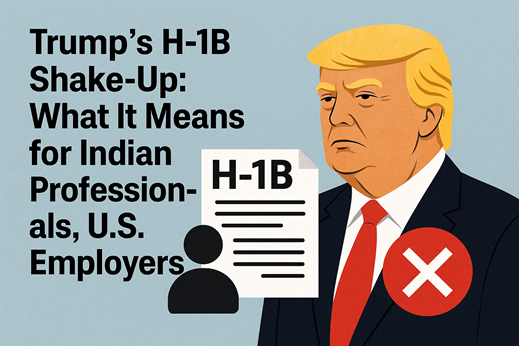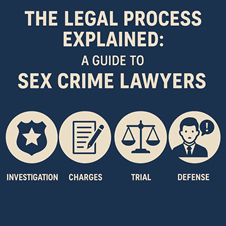Trump’s H-1B Shake-Up

What It Means for Indian Professionals, U.S. Employers, and the “Gold Card” Idea
The U.S. immigration playbook is poised for major edits again. The Trump administration has signaled sweeping changes to both the H‑1B work visa and the Green Card process, framing the reforms as a push to “hire American” and select the “best people” to settle in the United States. Commerce Secretary Howard Lutnick has publicly criticized the current H‑1B system as a “scam,” and previewed a proposed “Gold Card” pathway tied to large investments—rhetoric that has ricocheted across tech corridors from Silicon Valley to Bengaluru.
What’s on the table?
In media appearances and social posts, Lutnick said the administration is working to change the H‑1B program and revamp Green Card criteria, arguing that average earnings of green card recipients trail those of U.S. workers—a gap he frames as evidence for stricter, merit‑oriented selection. He also floated the “Gold Card” as an option for high‑net‑worth applicants, positioning it as a cleaner replacement for parts of the EB‑5 investor route.
Multiple outlets tracking policy moves add that the administration is reviving a wage‑based allocation concept for H‑1B—prioritizing petitions backed by higher salaries over the current lottery—an approach previously explored but not implemented after legal and political pushback. Recent reporting suggests the proposal is under federal review and, if finalized, could take effect for future cap seasons rather than immediately.
Why this matters (especially to Indian talent)
Indian professionals have historically been the primary beneficiaries of H‑1B visas—a program capped at 85,000 slots annually (65,000 regular cap plus 20,000 for U.S. advanced degree holders). Any pivot from a lottery to salary‑tiered selection could tilt the field toward senior, higher‑paid roles at large firms, reducing chances for entry‑level STEM grads and smaller employers outside high‑wage metros.
If the wage‑based rule lands on the timeline immigration trackers expect, the current process would likely continue through FY 2026, with changes kicking in from FY 2027. That gives students, employers, and families a limited runway to adjust strategies around OPT, cap‑gap planning, and offer structures.
The Politics—and the Pushback
The debate is as much political as it is technical. Florida Governor Ron DeSantis amplified the critique on Fox News, calling H‑1B a “total scam” that companies exploit—especially during an AI‑disrupted job market—by laying off Americans while seeking new visas. Supporters of H‑1B counter that the program fills critical skill gaps and fuels innovation across the U.S. economy.
Meanwhile, business and immigration analysts are parsing the “Gold Card” concept. Summaries by global advisors note the administration’s pitch: a multi‑million‑dollar payment in exchange for lawful permanent residence and a path to citizenship, with some commentary suggesting it could replace or sit alongside EB‑5. Experts also caution that Congress ultimately controls immigration law, so any wholesale replacement of EB‑5 would face legal and legislative hurdles.
Practical implications: near‑term and mid‑term
1) For Employers
If a wage‑based H‑1B selection is finalized, compensation levels become a strategic lever. Expect intensified competition for senior roles, while small businesses and startups in lower‑salary regions may need creative talent strategies—remote teams, near‑shore hubs, or alternative visas—to keep pace.
2) For Students and Early‑Career Talent
New grads on OPT could face tougher odds under wage prioritization. Proactive steps—internships that convert to higher‑pay offers, niche skills (AI safety, cybersecurity, RAG/GenAI ops), and regional mobility—may improve profiles ahead of FY 2027.
3) For Families on the Green Card Path
If merit‑ or earnings‑based filters tighten, timelines and eligibility may shift in employment‑based streams. Watch for official rule text and comment periods; until then, EB‑2/EB‑3 planning and documentation rigor remain essential.
4) For High‑Net‑Worth Applicants
“Gold Card” chatter sounds enticing, but details remain fluid. Advisories underscore that EB‑5 is still active, and replacing it would require congressional action—not just administrative announcements. Consider it speculative until rulemaking or legislation is published.
What to do now: a readiness checklist
- Track the rule text, not just the headlines. Look for a proposed rule in the Federal Register and the ensuing public comment window before you assume effective dates. Immigration news trackers currently flag FY 2027 as the earliest realistic start for a wage‑based system.
- Scenario‑plan compensation. Employers should model how Level 1–4 wages and locality pay impact selection odds; candidates should benchmark offers against prevailing wages to improve competitiveness.
- Mind the politics—and timelines. Policy direction can shift quickly; reporting shows the White House and Commerce Department are actively messaging change, while state‑level leaders keep the pressure on H‑1B. Expect iterative announcements before final rules land.
- Investor routes: proceed with caution. If you’re considering a capital‑linked residency route, consult counsel on EB‑5 versus any future “Gold Card” option, and don’t assume interchangeability until statutes or regulations are published.
For Indian professionals and U.S. employers, the likely near‑term reality is planning under status quo through FY 2026, then adapting to potential wage‑tiered selection from FY 2027 if the rule is finalized. Keep your documents clean, your comp strategy sharp, and your eyes on the Federal Register—not just the news cycle.
Searching for Legal Services? Let’s make your search simple with professionals!
Take your Legal Services to the next level with Sulekha. Boost your online visibility, connect with more clients, and grow effortlessly!
Blogs Related to Legal Services

Trump’s H-1B Shake-Up
What It Means for Indian Professionals, U.S. Employers, and the “Gold Card” Idea The U.S. immigration playbook is poised for major edits again. The Trump administration has signaled sweeping changes to both the H-1B work visa and the Green Card proc

Slip, Trip, and Fall Accidents: What You Do Next Matters
Slip, Trip, and Fall Accidents: What to Do Immediately and Why It Matters A sudden slip on a wet floor, a trip over uneven pavement, or a fall down poorly lit stairs—these accidents happen in seconds but can leave lasting consequences. Whether it

Safe Driving in Winter Conditions: Tips for a Smooth Commute
Winter Driving Safety: Smart Tips for a Safer Commute in Cold Weather As winter rolls in across the U.S. and Canada, icy roads and unpredictable weather can turn a routine drive into a risky journey. Whether you're commuting to work or heading out

Involved in a Car Accident? Here’s what to Do Immediately after a Collision
A car accident can be a jarring experience—whether it’s a minor bump or a major crash. In the moments that follow, it’s easy to feel overwhelmed. But knowing what steps to take can protect your health, your rights, and your financial future. Here’s

When to Lawyer Up: Everyday Situations That Need Legal Advice
From landlord squabbles to bizarre workplace policies, legal trouble often shows up without a courtroom. This blog walks you through surprisingly common moments when having a lawyer on speed dial is not just smart—it’s essential. 1. Spoiler: It’s

The Legal Process Explained: A Guide to Sex Crime Lawyers
When facing legal challenges, especially those involving serious allegations like sex crimes, understanding the legal process is crucial. The proper legal representation can make a profound difference. This guide walks you through what sex crime lawy




